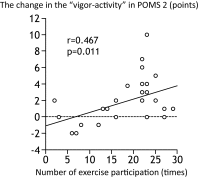The practice of active rest by workplace units improves personal relationships, mental health, and physical activity among workers
- PMID: 27980249
- PMCID: PMC5478529
- DOI: 10.1539/joh.16-0182-OA
The practice of active rest by workplace units improves personal relationships, mental health, and physical activity among workers
Abstract
Aim: This study was designed to clarify the effects of active rest, with a focus on the practice of short-time group exercise by workplace units, on personal relationships, mental health, physical activity, and work ability among workers.
Methods: Fifty-nine white-collar workers (40 males and 19 females) performed our active rest (short-time exercise) program, which consists of warm-up, cognitive functional training, aerobic exercise, resistance training and cool-down for 10 minutes per day, 3 times per week during their lunch breaks for 10 weeks. Participants from a workplace unit were randomly allocated to the intervention (five workplaces, n=29) or control groups (six workplaces, n=30). The participants' anthropometric measurements, and their Profile of Mood States (POMS) 2, Brief Job Stress Questionnaire (BJSQ), physical activity levels and Work Ability Index were examined at the baseline and after the 10-week intervention.
Results: After 10 weeks, physical activity levels, especially the time spent in moderate and vigorous intensity, increased in the intervention group (p<0.05). The items of "vigor-activity" and "friendliness" improved in POMS 2, while "vigor," "interpersonal stress," "support from superiors, colleagues, and family/friends," and "job satisfaction" improved in BJSQ in the intervention group (p<0.05). In the intervention group, the number of exercise participation was positively correlated with the change in "vigor-activity" in POMS 2 (r=0.467, p=0.011).
Conclusions: These results suggest that the practice of active rest by workplace units is important for improving personal relationships, mental health, and physical activity among workers.
Figures




References
-
- Koizumi K, Fujita Y, Muramatsu S, Manabe M, Ito M, Nomura J. Active recovery effects on local oxygenation level during intensive cycling bouts. J Sports Sci 2011; 29: 919-926. - PubMed
-
- Greco CC, Barbosa LF, Caritá RA, Denadai BS. Is maximal lactate steady state during intermittent cycling different for active compared with passive recovery? Appl Physiol Nutr Metab 2012; 37: 1147-1152. - PubMed
-
- Ministry of Internal Affairs and Communications 2015 WHITE PAPER Information and Communications in Japan. [Online]. [cited 2016 Aug. 18]; Available from: URL: http://www.soumu.go.jp/johotsusintokei/whitepaper/eng/WP2015/2015-index....
-
- Ohta M, Mizoue T, Mishima N, Ikeda M. Effect of the physical activities in leisure time and commuting to work on mental health. J Occup Health 2007; 49: 46-52. - PubMed
-
- Ohta M, Takigami C, Ikeda M. Effect of lifestyle modification program implemented in the community on workers' job satisfaction. Ind Health 2007; 45: 49-55. - PubMed
Publication types
MeSH terms
LinkOut - more resources
Full Text Sources
Other Literature Sources
Medical

